The ‘Averageness Hypothesis’ of attractiveness
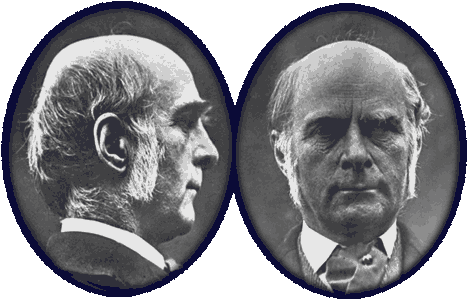 |
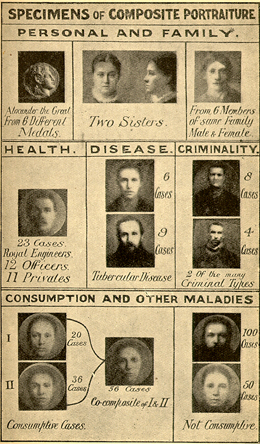 |
| Sir Francis Galton and his composite portraits |
|---|
In the 1800s, Sir Francis Galton created composite images of faces by projecting face photographs of many different individuals onto a single piece of photographic film. This was done in an effort to visualise the facial characteristics that were common to a particular group of people (e.g. to represent the typical face of criminals or soldiers). When Galton showed these images to his colleagues, however, they unanimously agreed that these composite faces tended to be more attractive than the individual face photographs from which they were manufactured (i.e. the composites tended to be more attractive than their constituent faces).
 |
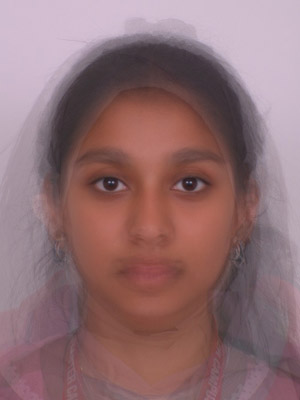 |
| Computer Method | Galton's Method |
|---|
More recently psychologists have used computer graphic methods to manufacture composite faces (sometimes referred to as ‘average faces’ or ‘face prototypes’) with the average characteristics of their constituent faces. While Galton aligned the constituent images using the distance between the pupils, causing the images to appear somewhat fuzzy, these more modern computer graphic methods warp each of the constituent faces into the average shape for the sample before blending the images together. This process ensures that the images created are sharper than those created using Galton's methods.
It is well established that composite faces manufactured using these computer graphic methods tend to be perceived as more attractive than the average attractiveness rating of their constituent images (as Galton's composites also were). That composite faces tend to be judged as more attractive than their constituent images led many researchers to conclude that ‘attractive faces are only average’. In other words, many researchers that had noted the high attractiveness of composite faces proposed that averageness is the critical determinant of attractiveness. This is often referred to as the ‘Averageness Hypothesis’. One explanation put forward for the effect of averageness on facial attractiveness is that average faces most closely resemble mental representations of a typical face and can therefore be processed most easily by the visual system (this explanation is similar to the perceptual bias account of symmetry preferences in that it emphasises a possible link between the ease with which faces can be processed and their attractiveness).
 |
 |
 |
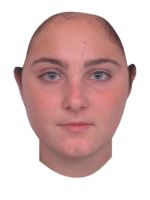 |
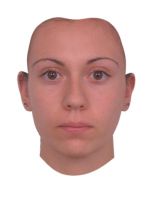 |
 |
| Individual Faces | Composite Face | ||||
|---|---|---|---|---|---|
Testing the Averageness Hypothesis
In a classic study of facial attractiveness, Perrett et al. (1994) tested the Averageness Hypothesis in an effort to establish if averageness really is the critical determinant of the attractiveness of faces. Perrett et al. first collected a full face photographs of 60 young women (these photographs were taken under the same lighting conditions). One group of participants then were shown these images and asked to rate the attractiveness of each face using a 1 (very unattractive) to 7 (very attractive) scale. Next, Perrett et al used computer graphic methods to manufacture a composite face with the average shape of the whole sample (i.e. to construct the average of all 60 female faces) and a second composite face which was the average of the 15 faces that had been judged to be the most attractive by the first group of participants. Perrett et al. then manufactured what they called a ‘hyper-attractive’ composite face (i.e. a version of the composite of the attractive faces in which its attractive qualities were exaggerated or caricatured) by exaggerating (i.e. caricaturing) the physical differences in shape between the composite of all 60 faces and the composite of the most attractive 15 faces using computer graphic methods.
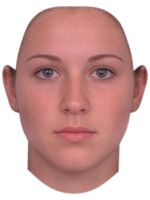 |
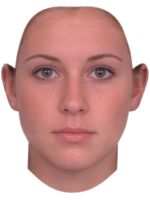 |
 |
| Composite of 60 Faces | Composite of 15 Most Attractive Faces | Hyper-Attractive Composite |
|---|
Intriguingly, Perrett et al. found that when a new group of participants were asked to rate the attractiveness of each of the 3 composite faces (the average of all 60 faces, the average of the 15 most attractive faces and the ‘hyper-attractive’ that had exaggerated attractive qualities) the hyper-attractive face was considered the most attractive of the 3. This is noteworthy because the hyper attractive face was mathematically the least average of all 3 composites. Because the hyper-attractive face was the least average of the 3 composites judged, but also the most attractive, this finding is very strong evidence that averageness is not necessarily the critical determinant of facial attractiveness. In other words, Perrett et al's findings are evidence against the Averageness Hypothesis of facial attractiveness (which proposes that ‘attractive faces are only average’) because the findings show that highly attractive faces deviate systematically from an average shape.
Try it yourself by making your own averages. Choose how many images to average together and see if more average faces really are more attractive and if the average of attractive faces is more attractive than the average of faces not selected for attractiveness.
Suggested further reading
- (504 kB) (1994). Facial shape and judgments of female attractiveness. Nature, 368: 239–242.